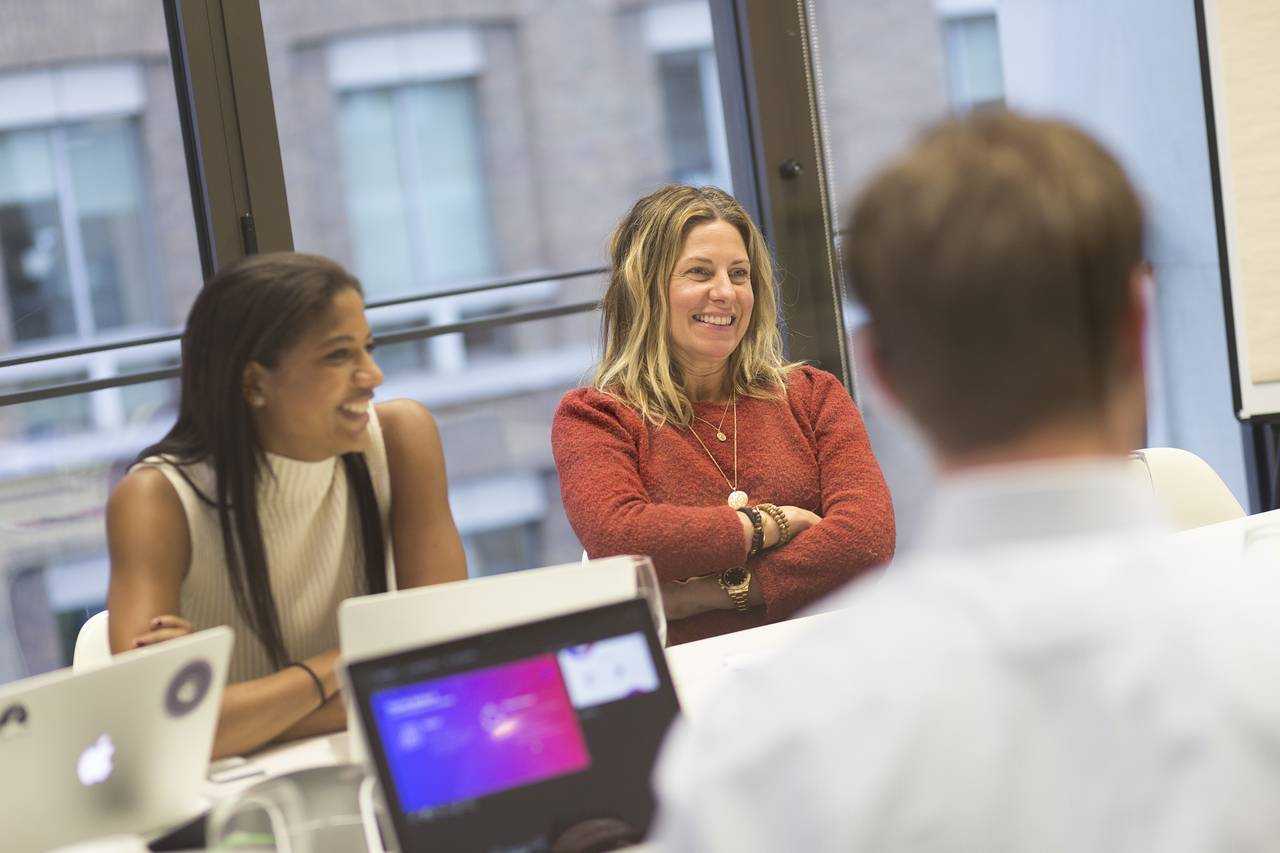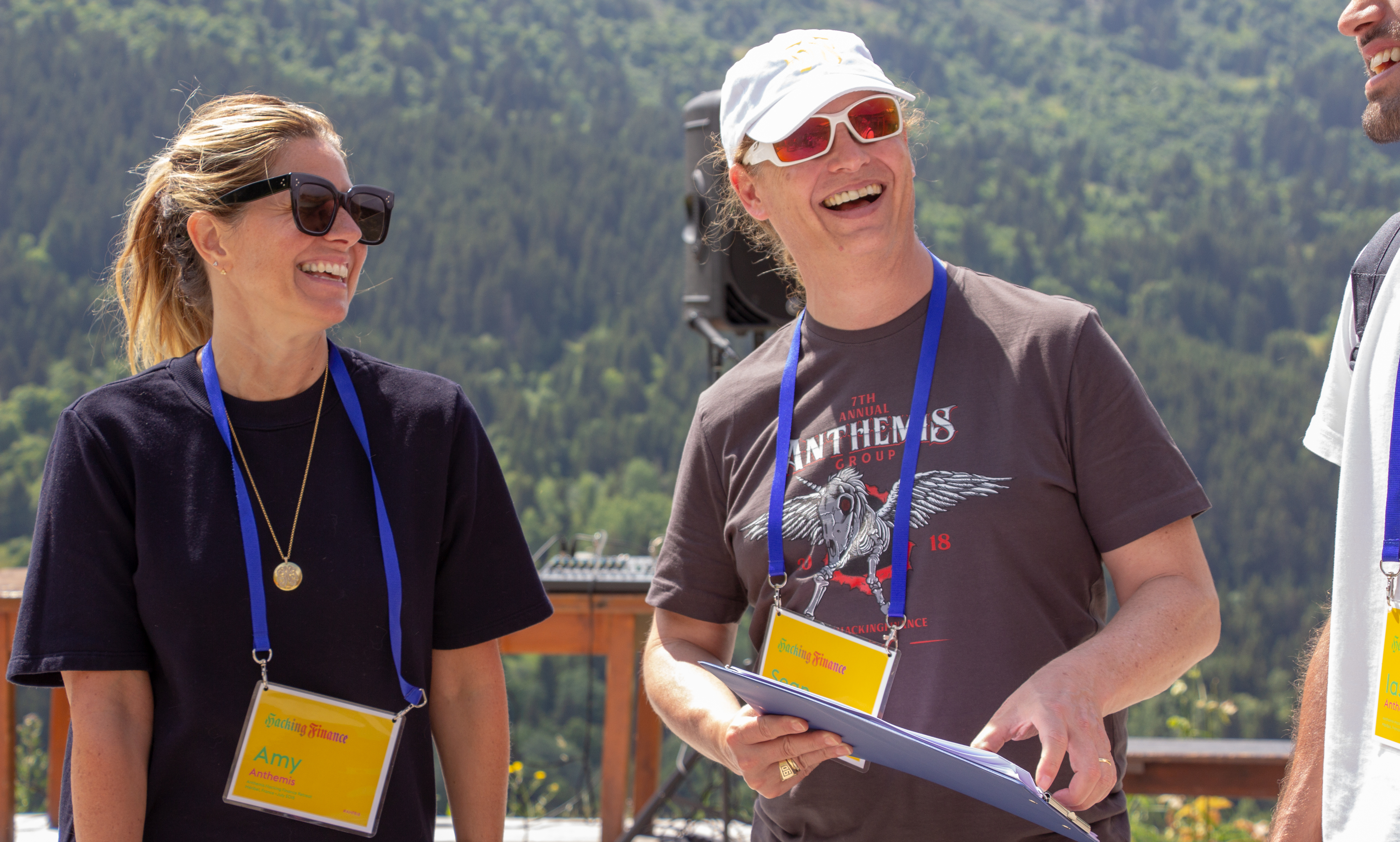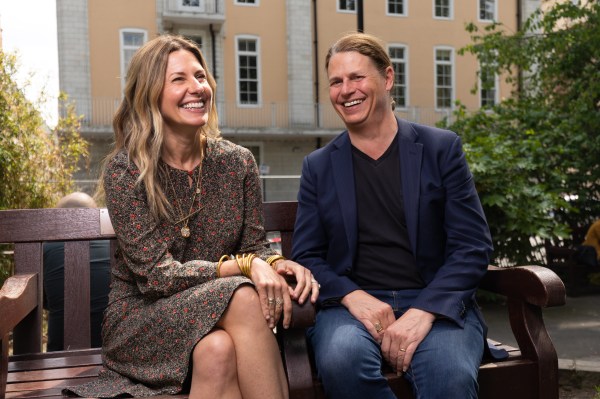Entering into the world of Anthemis is a bit like stepping into the frame of a Wes Anderson film. Eclectic, offbeat people situated in colorful interiors? Check. A muse in the form of a renowned British-Venezuelan economist? Check. A design-forward media platform to provoke deep thought? Check. An annual summer retreat ensconced in the French Alps? Bien sûr.
Sitting atop this most unusual fintech(ish) VC is its ponytailed founder and chairman Sean Park, whose difficult-to-place accent and Philosophy professor aura belie his extensive fixed income capital markets experience. He’s joined by founder and CEO Amy Nauiokas, who in addition to being one of Fintech’s most prominent female investors also owns a high-minded film and television production company.
When Arman Tabatabai and I recently sat down with Park and Nauiokas in their New York office, the firm’s leaders were in an upbeat mood, having blown past the temporary perception-setback associated with the abrupt resignation last year of Anthemis’ former CEO Nadeem Shaikh (for more on this, read TechCrunch writer Steve O’Hear’s coverage of the situation).
And as the conversation below demonstrates, Park and Nauiokas are well poised to bring the quirk into everything they touch, which these days runs the gamut from backing companies involved in sustainable finance, advancing their home-grown media platform and preparing a soon-to-be-announced initiative elevating female entrepreneurs.
Gregg Schoenberg: With the two of you now at the helm, how does Anthemis present itself today?
Sean Park: I’ll step back and say that when Amy and I were working at big financial institutions in the noughties, we saw that the industry was going to change and that existing business models were running into their natural diminishing returns.
We tried to bring some new ideas to the organizations we were working in, but we each had epiphany moments when we realized that big organizations weren’t built to do disruptive transformation — for bad reasons, but also good reasons, too.
GS: Let’s fast forward to today, where you have several strong Fintech VCs out there. But unlike others, Anthemis puts weirdness at the heart of its model.
Yes, you’ve backed some big names like Betterment and eToro, but you’ve done other things that are farther afield. What’s the underlying thesis that supports that?
Amy Nauiokas: Whatever we do at Anthemis has to be a non-zero-sum game. It has to be for good, not for evil. So that means that we aren’t looking in any place where you see predatory opportunities to make money.

Arman Tabatabai: You’re also pushing a services model, right?
AN: Services model or platform model, yes, and we’ve been doing it for a very long time, which we did on our own dime.
AT: Why does that matter?
AN: It helped tremendously when we were talking to investors because we were not asking them to pay for it.
SP: I’d add that we were very deliberate in the sense of saying, “We want to build this piece of organizational middleware that connects the innovators, the start-up companies, the people and businesses to the incumbents.”
GS: Why were you looking to be cooperative with financial services incumbents during a period when many in the Fintech community were still in dart-throwing mode?
AN: We have always believed in an evolutionary, not revolutionary, approach. And that certainly played out. I think a lot of folks now will admit that things need to be done in cooperation with the incumbents.
GS: In that vein, and in recognition of the influence Carlota Perez has had on Anthemis, I want to read you this quote from her: “I’m the most pessimistic optimist you’ll ever meet. I’m not proposing that we do something that is nice. I’m proposing that we do something that’s urgent.” Do you share that urgency?
AN: I’ll speak for myself, but I accidentally fell into financial services after college. I’m now old enough to recognize that in my lifetime, I’m not curing cancer. But for me, this feels absolutely urgent, because
if we don’t get the financial services layer right, lots is going to go wrong in our capitalist society.
GS: Speaking of that, I’d like to talk about your in-house media initiative Hacking Finance, which is a key carrier of the messages you want to promote.
SP: It’s a media platform driven by our belief that it’s fundamentally important that the financial system works correctly. We liken it to the anthropomorphic analogy of the nervous system of our society.
GS: You mean that if it’s not working well…
SP: If it’s sick or broken, it’s catastrophic. If it works well, it should be mostly invisible. In that context, I used another metaphor very early on when I gave a presentation at SWIFT. Do you know what they do?
GS: Yes. It’s the Belgian cooperative that helps banks and other financial institutions send payment orders to each other.
SP: I delivered a keynote there where I used the metaphor of the Protestant Reformation.
I likened the financial industry to the Catholic Church, you know, just, “Trust us,”
AN: It started as a summit in Méribel of people in our ecosystem, and it grew from there and has been 100% funded by and supported by Anthemis. But we deliberately launched Hacking Finance separately, because we want it to live without us. We actually launched it last year on May Day at the Brooklyn Library.

GS: Excellent choice of borough. In watching the videos, though, my reservation about Méribel is that it looks like a posh Fintech version of the Allen & Company Sun Valley thing. In other words, not very accessible despite your focus on democratizing finance.
AN: Totally, and it’s a work in progress. But one of the struggles that I’ve always had operating within financial services is always feeling like “the other” in the room. Where I think we get an A is in how we’ve collected our portfolio companies and helped navigate them in this world of diversity and inclusion. Where we continue to get stuck is in the ecosystem. It frustrates me every day, but we’re chipping away at it.
GS: Let’s talk about the deals you’ve done for start-ups that I’d characterize in the environmental resiliency bucket more than in the Fintech one.
Realistically, can we save the planet on the back of well-intentioned private actors like you making innovation investments, along with a few intergovernmental agencies and a handful of mostly Scandinavian countries? Is it enough, or are we pretty much fucked if the status quo is maintained?
SP:
If things stay this way, I think we’re kind of fucked.
GS: Oh Yes. That region produces some of the world’s heaviest crude. It costs a lot to extract, emits an above average amount of CO2 and leads to these ghastly wastewater lakes.
SP: It’s horrific, but it helped me to appreciate that Industrial-age finance is actually built on fossil fuels.
AT: How so?
SP: Because the unit of account is energy via oil and gas plus some coal. Of course, I’m biased in seeing the world through the lens of finance, but one of the things that needs to happen for an energy revolution to take hold is for the financial complex to change.
AT: Your hope lies then in changing the way new energy projects are financed?
SP: Yes, and this is one of the reasons we were excited about kWh Analytics. I don’t think many VCs get it, but it’s about infrastructure finance.
And with infrastructure finance, you’re talking about trillions of dollars and a whole new infrastructure to convert it from a specialist finance product to a commodity product. We saw in kWh Analytics a piece to solving that puzzle, and we concluded that we could back that.
AT: Gregg and I actually spoke to Richard Matsui (CEO of kWh Analytics) about Anthemis. In our discussion, he reinforced this idea that Anthemis was unique in understanding both the Fintech and clean tech aspects of its business. How were you able to do that?
SP: My knowledge of debt capital markets and experience as an early investor in and director of Markit allowed us to immediately understand the potential of the platform Richard and Jason were building. Without an insider’s understanding of the workings of the infrastructure financing market, the real upside of what they were building wouldn’t have been visible.
AN: I’ll add that I grew up in a lower-middle-class community, where my dad was a mechanic who built our house. What would stop him from doing it in a green way today would be the financing. So if we can fix finance at the infrastructure level, maybe it can flow into the retail economy.

LED Bulb and Coin stack – Saving concept
GS: When you decided to do deals in resiliency, did any of your LPs say, ‘WTF? This isn’t Fintech, and it’s not what we thought we were getting when we backed you’?
AN: No, and quite frankly, if they did, they wouldn’t be our LPs. And look, we’re not going to be for everybody, and that’s okay.
GS: Can you give us another example of a start-up you backed that links financial services and environmental resilience?
AN: Take Flo Technologies. It’s a perfect example of a company that most other Fintech investors wouldn’t characterize as a Fintech company, but when we looked at it, we saw it fitting in.
GS: How does it fit?
AN: Flo is a great example of a technology that enables the business of insurance to move from one focused on simply mitigating financial loss to one focused on risk management and mitigation. It’s a business model transformation that we see as fundamental to the future of the insurance industry.
GS: I see that Flo posts blogs with titles like, “Everything You Need to Know About Pressure-Reducing Valves.”
AN: Actually, water damage from leaks is the number one home insurance claim payout category globally. By focusing on the detection and prevention of leaks, Flo is solving a problem for insurers and consumers alike.
AT: I think this company ties back to the idea of embedded finance. Can you elaborate on that?
SP: Our view is that finance, as a system in our society, is sort of broken. And part of that brokenness is that it’s super apparent. But if we succeed in fixing it, it should go back to being an invisible but critical infrastructure that helps our lives run. When I first used Uber, for example, I thought the most fabulous thing about it was that I didn’t have to pay. Of course I did pay, but the payment was embedded.
GS: Turning beyond Fintech, Amy, I want to cover your media and entertainment company, because deep down, most everyone on Wall Street and in Silicon Valley wants to dabble in the movie business. How did you go about starting Archer Gray while also building up your fund?
AN: I started from the content creation and producing side, in large part so I could understand what made the media industry tick, assuming I’d eventually go in as a venture investor in media tech. I knew the space was ripe and ready for venture investment because I saw so many similarities and adjacencies to the financial services sector. What I didn’t know was that producing content and learning about media would make me a better investor.
GS: How so?
AN: It gave me a great perspective on trends, consumption patterns and the cultural zeitgeist, all of which support my ability to understand how and when products and services will resonate in the markets. I also recognized that many of the trends I’d grown up within financial services were at play in the media industry as well, only in a slightly delayed fashion.
GS: What are the similarities you saw?
AN: Like large incumbents holding on too long to the past and resisting collaboration and change, disintermediation of brokers and middle-men, and the “exchangification” of products and services. But most importantly, we saw a distinct opportunity to drive a thesis at the intersection of media and finance, by investing in companies and sectors where finance is embedded at the core of new media business models.

AT: What’s an example of that?
AN: Think about the new social media economy, or ‘metaverse’ communities in gaming.
GS: Wall Street is strewn with the carcasses of smart people who made a side-hustle bet in the entertainment business and got slaughtered. What did you understand that most other finance-types don’t?
AN: It was a combination of two things. One was a recognition of my own strengths and weaknesses as a manager and a businessperson. The other was recognizing that the real pressure on media was going to be about consumption. If you think about where Netflix was in 2010, it was still delivering DVDs to your mail.
GS: Were films the first main target?
AN: Yes, feature films that could break through because their story could break through — films like 20th Century Women and Can You Ever Forgive Me?
GS: You’ve done things besides films, though.
AN: Yes. For example, we funded ONCE on Broadway, which I think was the first play on Broadway to invite audience members to go up on stage, and it nailed the fact that there’s magic in that experience. We look at digital content and social impact documentaries, too, and have built a venture part into the business.
GS: Let’s end by talking about putting more women on the Fintech stage. Can you share what you’re cooking up on that front?
AN: Here’s what I fundamentally believe: We have a pipeline problem in financial services with women. It’s not that they’re not there, but it’s harder to find female entrepreneurs who have the ideas, the framework and the network to be able to launch their own companies into the stratosphere.
GS: I take it you’ve looked?
AN: We’ve probably looked harder than any other VC.
The challenge is finding the female talent and attaching them to really great ideas.
GS: Slowly but surely, I think there’s a recognition of the economic upside of diversity, not just the check-the-box kind of diversity that existed for a long period of time.
AN: Yes. Diversity is good business. It’s just good business.
GS: On that note, Amy, Arman and I wish you and Sean continued success in all of your diverse initiatives.
This interview has been edited for content, length and clarity.
Updated: Added link to previous TechCrunch coverage of Anthemis concerning its former CEO and allegations of sexual harassment.
